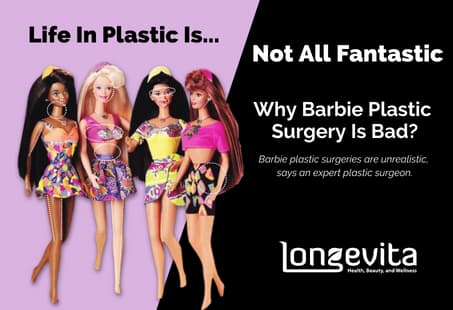Barbiefication of the classic Instagram face and body is a dangerous trend, and patients seeking surgeries to look more like Barbie should be screened for psychiatric illnesses like body dysmorphic disorder (BDD), says plastic surgeon Prof Dr Fuat Yuksel.
Slanted, almond eyes, puckered, pink lips, an inconspicuous, bridgeless nose, and a cinched waist with a disproportionately large bust and butt have made the iconic Barbie for the longest time. Decades of generations have grown up playing with and emulating this very Barbie, so even though Mattel’s been focusing on diversity, it hasn’t really sunk in yet.
And this has implications for those living in the hyperreality of social media, which, in today’s day and age, is most of us. Among its many problems is the warping of the “ideal” beauty standards, which are now also being “Barbiefied.” And this can lead to an increased demand for the ultimate Barbie face and body.
“There are many different surgeries that people seek for this “Barbiefication.” It could be anything from rhinoplasty, blepharoplasty, breast augmentation, BBL, liposuction, tummy tuck to even rib removal and labiaplasty.”
“Many women have these surgeries to feel more confident and have a better body image. But it’s extremely important to screen patients for a psychiatric illness like body dysmorphic disorder,” says Dr Yuksel, who’s been a practising plastic surgeon for more than 35 years and works with the UK-registered medical tourism facilitator Longevita.
Body dysmorphic disorder is a mental illness in which people are extremely bothered by real or imagined flaws in their appearance. It’s considered a contraindication for plastic surgery, which is why many surgeons refuse to perform plastic surgery on such patients.
“Because of figures like Barbie, a lot of young girls enquire about plastic surgeries. But I have to refuse surgery to such patients because of their unrealistic expectations and risks to their mental and physical health.”
You only have to look at the “Barbie nose” for an example. The nose is thin, short, upturned, and lacks any nasal flaring. On paper, it might not sound too bad, but in real life, it looks disproportionately small. Also, it can be downright dangerous because of its potential complications like nasal collapse and breathing difficulties.
Dr Yuksel also went on to say, “At the end of the day, it’s important to remember that Barbie is not real, so you shouldn’t try to make it real either. Let her stay in the Barbie world.”
While plastic surgery has many benefits, it’s important to keep in mind that physical appearance alone doesn’t guarantee happiness in any way. As even the reel-life Barbie lives in the real world, we should follow in her those footsteps.

